Why I love researching carrots
Dr Charlotte Allender, School of Life Sciences
Published September 2013
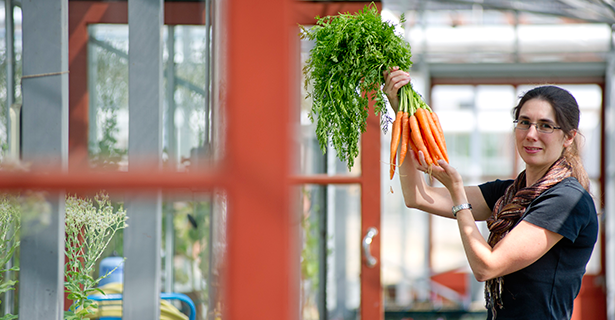
Carrots are an economically and nutritionally important crop in the UK as well as globally. The value of carrot production in the UK is estimated at £290 million [source]. Carrots are a major source of alpha and beta carotenes which belong to a group of compounds known as carotenoids. Carotenoids like alpha and beta carotene are responsible for giving carrots the orange colour we are so familiar with but a range of other pigments can be present to give carrots several different colours not usually found on the supermarket shelves. Dr Charlotte Allender, School of Life Sciences, gives 14 of the reasons why she loves researching the root vegetable.
1. It's a big business
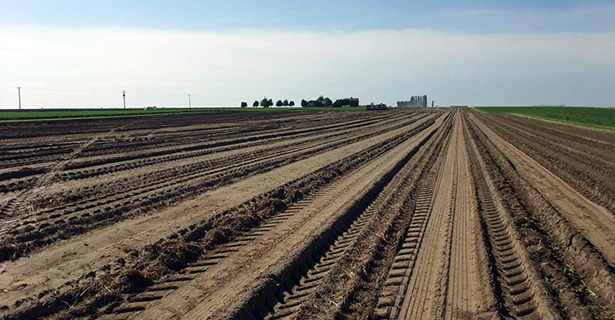 Carrot productions is big business in many parts of the world. In parts of Washington State, USA, large areas of carrots are grown; production is aided by a wonderfully fine soil structure and easy access to irrigation water from the Colombia River system. The photograph shows the soil after carrots have been harvested; the curved track on the left hand side is the path travelled by the outer wheel of the central pivot irrigation beam. The results of this irrigation system can be seen as lush green circles in an area where the natural vegetation is more suited to deserts.
Carrot productions is big business in many parts of the world. In parts of Washington State, USA, large areas of carrots are grown; production is aided by a wonderfully fine soil structure and easy access to irrigation water from the Colombia River system. The photograph shows the soil after carrots have been harvested; the curved track on the left hand side is the path travelled by the outer wheel of the central pivot irrigation beam. The results of this irrigation system can be seen as lush green circles in an area where the natural vegetation is more suited to deserts.
2. We develop carrots that withstand the rigours of mechanised agriculture
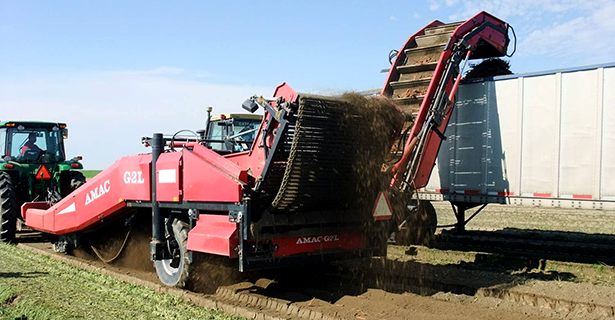
Large-scale carrot production is highly mechanised. Here, a crop of carrots is being harvested in Washington State, USA. The leafy tops are cut off at ground level and the roots are then lifted from the soil. These carrots are destined for further processing and will likely be sold in bags as ready-prepared for snacking and cooking. Plant breeders need to be able to produce carrot varieties which give a good yield, reach the required size at the same time and are able to withstand the rigours of such mechanised agriculture.
3. You can get white carrots
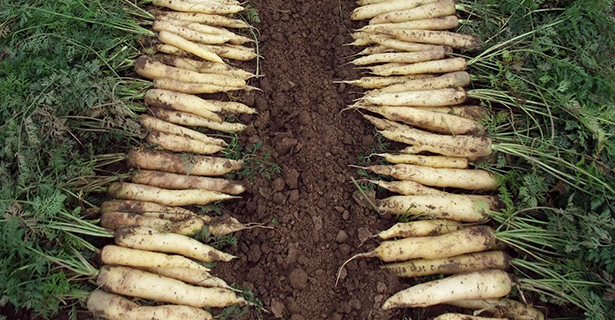
White carrots (pictured above: White Satin carrots) are also available. While they look similar to parsnips, the smell and texture are identical to orange carrots. White varieties do not accumulate any of the different carotenoid pigments. This inability to manufacture pigments is caused by natural mutations in the various genes which control carotenoid production.
4. And purple carrots
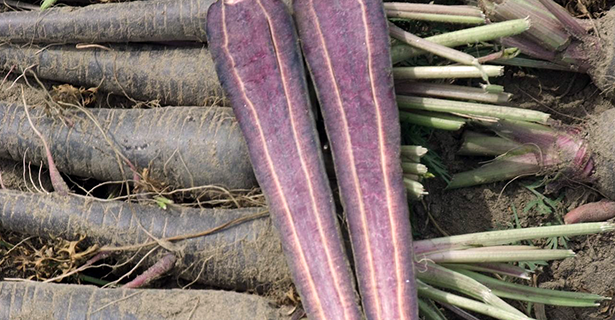 Varieties have been developed which combine the desirable characteristics of large, smooth roots and high levels of purple pigmentation. The pigmentation is caused by the production of a class of compounds called anthocyanins in the root tissue. Some varieties have such intense pigmentation that they are used as sources of natural food colouring in, for example, ice cream.
Varieties have been developed which combine the desirable characteristics of large, smooth roots and high levels of purple pigmentation. The pigmentation is caused by the production of a class of compounds called anthocyanins in the root tissue. Some varieties have such intense pigmentation that they are used as sources of natural food colouring in, for example, ice cream.
5. And yellow carrots
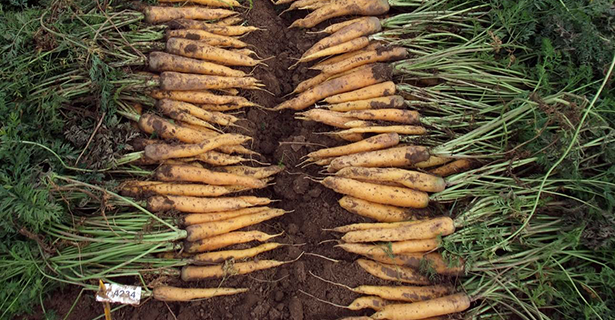 Carrots also come in yellow; these varieties have high levels of carotenoid compounds called xanthophyll (which confers the yellow colour) and lutein. Lutein is known to have particular nutritional benefits, including the promotion of eye and cardiovascular health. They taste and smell like the orange carrots we are more familiar with. Pictured above: Yellowstone carrots.
Carrots also come in yellow; these varieties have high levels of carotenoid compounds called xanthophyll (which confers the yellow colour) and lutein. Lutein is known to have particular nutritional benefits, including the promotion of eye and cardiovascular health. They taste and smell like the orange carrots we are more familiar with. Pictured above: Yellowstone carrots.
6. Oh, and red carrots too
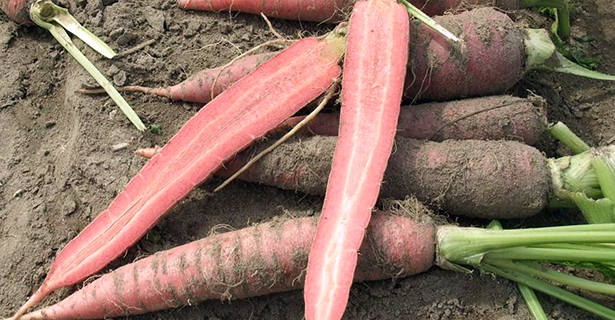 Carrots with a pink or reddish tinge are also available, although they tend to be grown in areas such as the Indian subcontinent. The red colouration comes from lycopene, a carotenoid compound also found in tomatoes. Lycopene has several known health benefits, including lowering the risk of prostate cancer in men. Other characteristics of red carrots from the Indian subcontinent and China mean it is more difficult to develop varieties suited to large-scale cultivation in Europe and the USA – for example they may flower prematurely and often have a rough skin.
Carrots with a pink or reddish tinge are also available, although they tend to be grown in areas such as the Indian subcontinent. The red colouration comes from lycopene, a carotenoid compound also found in tomatoes. Lycopene has several known health benefits, including lowering the risk of prostate cancer in men. Other characteristics of red carrots from the Indian subcontinent and China mean it is more difficult to develop varieties suited to large-scale cultivation in Europe and the USA – for example they may flower prematurely and often have a rough skin.
7. They also come in extra-extra-large size
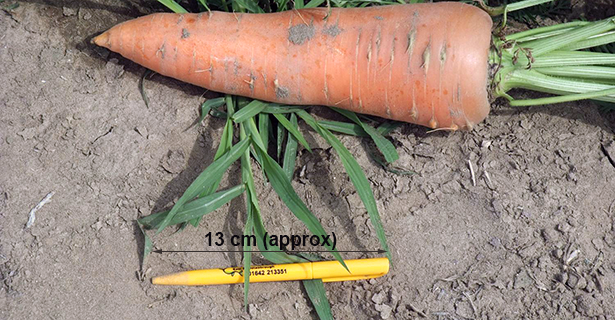 Carrots come in all shapes and sizes. Those grown for processing and freezing tend to be much larger than those grown for fresh consumption.
Carrots come in all shapes and sizes. Those grown for processing and freezing tend to be much larger than those grown for fresh consumption.
8. You can combine the colours
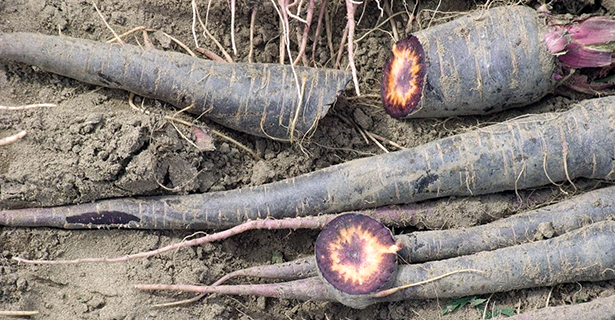 Plant breeders are developing varieties with beautiful combinations of pigments in different root tissues. Here, anthocyanins in the skin, inner core and outer flesh are combined with carotenes in the inner flesh to give a very attractive pattern.
Plant breeders are developing varieties with beautiful combinations of pigments in different root tissues. Here, anthocyanins in the skin, inner core and outer flesh are combined with carotenes in the inner flesh to give a very attractive pattern.
9. They have flowers
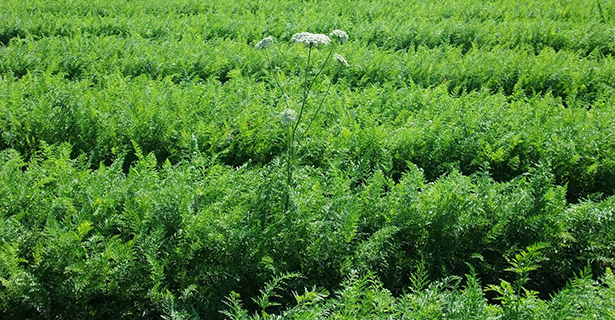 One trait not appreciated by carrot growers is a propensity to bolt – that is to say flower early. Carrot plants which flower too soon end up using the starch reserves in the root, causing it to shrink and toughen. These roots are not marketable so breeders work hard to remove this trait from the varieties they develop. Carrot varieties bred for sub-tropical climates are sensitive to the cool temperatures encountered in temperate regions, and this can cause them to bolt before roots are fully developed.
One trait not appreciated by carrot growers is a propensity to bolt – that is to say flower early. Carrot plants which flower too soon end up using the starch reserves in the root, causing it to shrink and toughen. These roots are not marketable so breeders work hard to remove this trait from the varieties they develop. Carrot varieties bred for sub-tropical climates are sensitive to the cool temperatures encountered in temperate regions, and this can cause them to bolt before roots are fully developed.
10. We use male sterility to control pollination
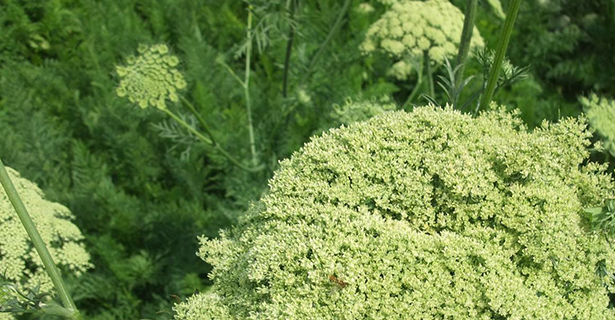 Carrot breeders use male sterility to control pollination in the development and production of new varieties. These plants do not produce pollen as (in the picture above) a naturally occurring genetic mutation means that the pollen producing organs (the anthers) develop instead into petal-like structures. Such plants are still receptive to pollen, and can be used to control crosses made during a breeding programme.
Carrot breeders use male sterility to control pollination in the development and production of new varieties. These plants do not produce pollen as (in the picture above) a naturally occurring genetic mutation means that the pollen producing organs (the anthers) develop instead into petal-like structures. Such plants are still receptive to pollen, and can be used to control crosses made during a breeding programme.
11. This is what the 'original' carrot looked like
 Carrots were developed from a wild plant now known as Queen Ann’s Lace. This wild species develops a storage root in the same manner as a cultivated carrot but it is thinner, white in colour and often has several branches. Carrot was first developed as a crop in central Asia. Through a process of selection, farmers developed a crop which is more familiar to us by keeping seed from plants with better tasting, smoother and larger roots. Unlike the veg from the fresh produce section of the supermarket, the first carrots were white and purple.
Carrots were developed from a wild plant now known as Queen Ann’s Lace. This wild species develops a storage root in the same manner as a cultivated carrot but it is thinner, white in colour and often has several branches. Carrot was first developed as a crop in central Asia. Through a process of selection, farmers developed a crop which is more familiar to us by keeping seed from plants with better tasting, smoother and larger roots. Unlike the veg from the fresh produce section of the supermarket, the first carrots were white and purple.
12. I use my research skills to help carrot breeders and growers understand the genetic mechanisms behind the vegetable's traits.
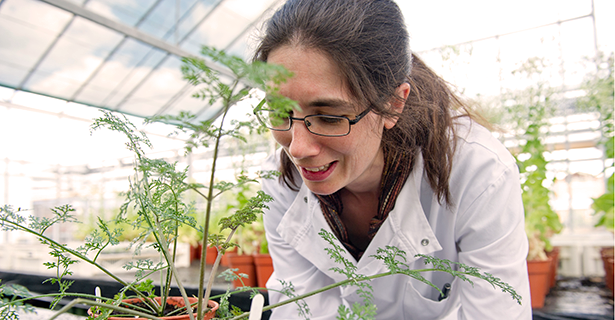 Researchers at the University of Warwick are interested in the genetic diversity of carrots, and in understanding the genetic mechanism controlling traits of interest to carrot breeders and growers. These include seed and seedling vigour (early growth of young plants after sowing), and the genetic basis of differences in flowering time.
Researchers at the University of Warwick are interested in the genetic diversity of carrots, and in understanding the genetic mechanism controlling traits of interest to carrot breeders and growers. These include seed and seedling vigour (early growth of young plants after sowing), and the genetic basis of differences in flowering time.
13. Imagine if your local supermarket carried more than 1,500 types of carrot
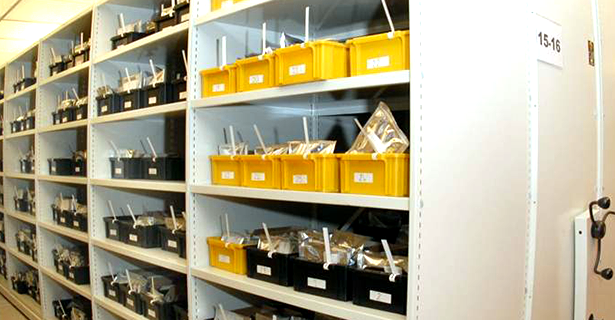 Warwick Genetic Resources Unit at the University of Warwick holds a collection of over 1,500 samples of carrots. This includes samples from related wild species, traditional varieties developed by farmers in many different countries and old commercial varieties. Seeds are stored at -20° C to maintain them long-term. Plant breeders and researchers can request seed samples for their work, and seeds are sent all over the world to support scientific research and crop improvement.
Warwick Genetic Resources Unit at the University of Warwick holds a collection of over 1,500 samples of carrots. This includes samples from related wild species, traditional varieties developed by farmers in many different countries and old commercial varieties. Seeds are stored at -20° C to maintain them long-term. Plant breeders and researchers can request seed samples for their work, and seeds are sent all over the world to support scientific research and crop improvement.
14. And could grow more if required
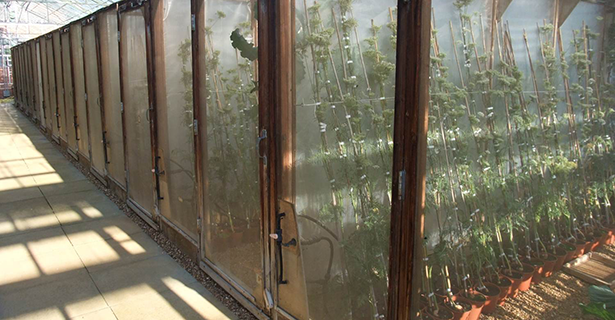 Seed samples are regenerated as required. Plants are grown out and fresh seed is harvested and put back into storage. Carrot is an outcrossing crop which means that care has to be taken to avoid cross-pollination between samples. Here, carrot plants are grown in isolation cages to prevent accidental pollen transfer.
Seed samples are regenerated as required. Plants are grown out and fresh seed is harvested and put back into storage. Carrot is an outcrossing crop which means that care has to be taken to avoid cross-pollination between samples. Here, carrot plants are grown in isolation cages to prevent accidental pollen transfer.
 Dr Charlotte Allender is interested in patterns of genetic diversity in a range of species, and the processes that affect them. She has used molecular markers to answer questions about the ecology and evolution of a variety of species from the native hazel Dormouse to African cichlid fish to brassicas.
Dr Charlotte Allender is interested in patterns of genetic diversity in a range of species, and the processes that affect them. She has used molecular markers to answer questions about the ecology and evolution of a variety of species from the native hazel Dormouse to African cichlid fish to brassicas.
She is the manager of the Genetic Resources Unit at the University of Warwick; a seed bank which maintains several globally significant collections of vegetable crops and related wild species. She is particularly interested in the patterns and nature of the distrubition of genetic diversity among crop species and their wild relatives. She lead a three year Defra funded project (IF0189) aimed at understanding the genetic diversity present in UK Brussels sprout varieties and how to maintain F1 hybrids within plant genetic resources collections. Charlotte in the process of designing and producing a standard carrot diversity set (Defra project IF0158), which will enable researchers and breeders from different institutions and countries to carry out trait and marker screening on a common set of lines.
